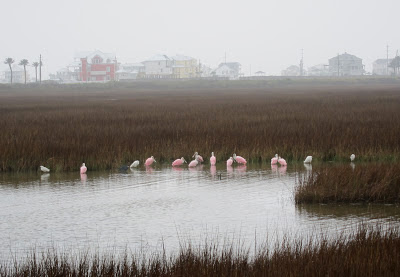Once, long
ago, Galveston Island was the home to a port, through which goods and
immigrants passed. A town grew up around the port, but the bulk of the island
was little else but scrubby growth, grasses and rattlesnakes. Well, birds lived
here, too, and the pirate Jean LaFitte had his headquarters on the bay side of
the island
Eventually
someone decided the island would be a good place to graze cattle. When we first
visited, several ranches lined the farm-to-market road that runs the length of
the island. The cattle were accompanied by a flock of white egrets.
Now the
ranches along this road have disappeared except for one. The remaining one is
just a couple of miles from our house. This year, as in some previous years, a
flock of sand hill cranes shares the pasture with cattle. The birds to not
appear in this photo, but they were feeding nearby.
People
began to build fishing shacks along the shore and gradually these were joined –
and replaced – by larger beach houses. Most beachfront houses today are
luxurious affairs like this.
Some take
the Mediterranean style.
Each
beachfront house has its private walkway over the dunes to the beach.
When the
seaside was filled with houses, developers began to buy up ranches and turn
them into housing lots, condominiums or resorts. This
resort is far more extensive than the photo indicates. It alone takes up an
entire former ranch.
This ranch
has been transformed into a gated community. A sign declares that trespassers
will be prosecuted.
Developers
also seized upon the marshy bay side of the island, dredged canals to the bay
and built houses of a more modest scale. We are living this winter on a confluence of two canals. This
is the patriotic view toward the Gulf from our deck.
Being a
country woman, I would have preferred the island before it filled up with houses, back when it was ranchland inhabited by
rattlesnakes and prickly pear.
Nature,
I’m sure, eventually with take it all back. Already there is an
encouraging sign. When we checked into our rental house this winter we found
this sign taped to the kitchen counter.
Copyright
2013 by Shirley Domer








































